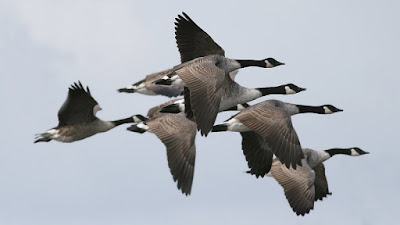 |
| Thousands of Canada geese winter in Greenwood State Wildlife Refuge. |
 |
| Map of Ice Age Trail through Greenwood State Wildlife Refuge. Click for larger version. |
The 1-mile segment (2 miles round-trip) of the Ice Age National Scenic Trail runs through Greenwood State Wildlife Refuge in Wisconsin’s Waushara County. This segment is on the eastern bifurcation of the 1200-mile long Ice Age Trail, which roughly traces where the last glaciers stood in the state some 10,000 years ago.
To reach the trailhead, from Adams-Friendship, take Wis. Hwy. 13 north then turn right/east onto Wis. Hwy. 21. Next, go left/north on County Hwy. GG then left/west onto Brown Deer Court. About 0.3 miles past Seventh Avenue is a parking lot on the road’s right/north side.
Hancock moraine
From the lot, the Ice Age Trail goes south to the Mecan Springs State Natural Area and east/north to Bohn Lake State Natural Area. Either route is a pleasant walk, but the northern route heads through more of the Greenwood refuge.
From the parking lot, take the trail north. The route mostly crosses a low portion of the Hancock moraine, which here is covered in oak and white pine.
The moraine formed at the end of the last ice age about 12,000 years ago when a melting glacier – the Green Bay Lobe – left behind piles and sheets of rock it had dragged and pushed as advancing. As plants took hold on the moraine, it solidified into rolling hills.
To the trail’s west is a pitted outwash plain, created when meltwater from the glacier deposited sediment as it flooded the area. The result is flat, sandy terrain.
Canada geese haven
The area is popular with giant Canada geese. Several thousand of the birds winter on the wildlife refuge’s 1438 acres.
With a black head, white cheeks and brown body, the Canada geese migrates between Arctic areas to North America’s temperate regions. They measure 30-43 inches in length and have a wingspan of 50-73 inches. Males can weigh up to 14.3 pounds, and the female is only slightly lighter.
Canada geese perhaps are most famous for the V-formation they fly in during their migrations. Each spring and autumn, hundreds of them will gather and then fly together to their new grounds. Their honking as they fly can be heard loud and clear over a great distance as they take flight.
The bird has been extremely successful in adapting to areas that humans have altered, whether they be farm fields or parks.
Lupines in spring
At times, the trail skirts the woodlands and meadows. In late May, purple lupine covers those open areas, making for a spectacular sight.
Where the trail reaches Seventh Drive just north of Brown Deer Court marks a good time to turn back. You can either retrace your steps through the woods to the parking lot or to shorten the hike walk west along the road shoulder to the lot for a 1.66-mile loop.
During summer, especially after rainfall, ticks can be a problem along the trail. Be sure to wear long clothing that covers your legs and arms and then to do a tick check after the hike.
